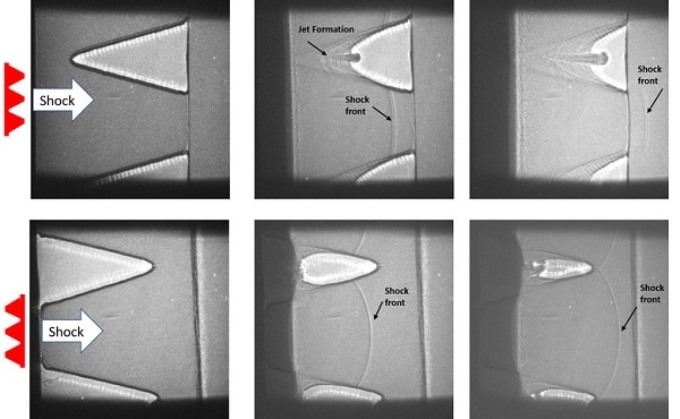May 31 2019
Through an Air Force Office of Scientific Research-funded basic research effort, the collaborative team developed a 3-D printed polymer-based foam structure that responds to the force of a shock wave to act as a one-way switch, a long sought-after goal in shock research.

Novel Material Configuration
According to AFRL Senior Materials Research Engineer Dr. Jonathan Spowart, this novel material configuration, although in the early stages of development, has the potential to be scaled up in order to be used in different ways for a variety of applications, including for the protection of structures.
Spowart describes the material as a foam-like structure that contains a series of specifically-engineered tiny holes that determine the overall behavioral characteristics. Over a period of months, AFRL experts used computer modeling to run trials to determine the most effective hole geometries to achieve the desired material response. When they would arrive at a promising configuration, Spowart says the team would print a small test article, a flat plate not much bigger than a pencil eraser. With the help of Los Alamos National Laboratory, working on-site at the Dynamic Compression Sector user facility at Argonne National Laboratory, they would then conduct tests and image the specimen using X-rays to determine performance.
Material’s Unique Directional Behavior
From there, the AFRL team would review results and fine-tune the material configuration to further refine the product through additional modeling and testing. Spowart described the end product as containing a series of hollow cones. When these cones encounter a shock wave, they collapse inward, forming jet protrusions that project from the opposite side. These jets localize the shock wave energy, which is the origin of the material’s unique directional behavior.
Spowart says this effort represents a significant breakthrough in materials engineering. He attributes this success to the collaboration, communication, and expertise of the teams at AFRL, Los Alamos, and Argonne National Laboratory, as well as the basic research funding from AFOSR.
Crediting the Modeling and Materials Expertise
“The materials technology came from AFRL,” he said, crediting the modeling and materials expertise of the project team. “The testing facilities and test methodology came from Los Alamos. So when you put the two things together, you get a really good team.”
He adds that the remarkable test imaging provided by Argonne National Laboratory was crucial in proving out the concept. He explained that the laboratory’s Advanced Photon Source synchrotron is a unique piece of equipment that fires a very powerful and concentrated X-ray beam at the test article, allowing frame-by-frame imaging of a shock wave penetrating the specimen, all of which occurs within a few nanoseconds.
New Imaging Capability
“This new imaging capability, together with the new manufacturing technology and computer simulations, allowed the team to obtain images and evaluate concepts in ways that were well beyond reach just a few years ago,” said AFRL Senior Mechanical Engineer and team member Dr. Christopher Neel.
“The Dynamic Compression Sector is a unique facility that enables in-situ imaging of dynamic events giving us unprecedented information of the microstructural effects on dynamic behavior,” added Los Alamos National Laboratory scientist Brittany Branch, who led the dynamic experiments.
“Traditional shock compression diagnostics would not elucidate the localization phenomena that is occurring during shock compression. We would see a difference in shock velocity with traditional techniques, but not understand why. These experiments were very exciting, since we demonstrated a shock diode for the first time.”
Spowart said the team plans to publish their findings and work toward transitioning the technology for further maturation and integration into existing systems, where he believes this technology has tremendous potential. “We are very excited about this effort and the teamwork that made it possible. This is great example of what basic research can do to strengthen our capabilities.”